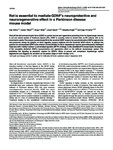Ret is essential to mediate GDNF’s neuroprotective and neuroregenerative effect in a Parkinson disease mouse model
| dc.contributor.author | Drinkut, A | |
| dc.contributor.author | Tillack, K | |
| dc.contributor.author | Meka, DP | |
| dc.contributor.author | Schulz, JB | |
| dc.contributor.author | Kügler, S | |
| dc.contributor.author | Kramer, Edgar | |
| dc.date.accessioned | 2017-08-11T10:10:23Z | |
| dc.date.available | 2017-08-11T10:10:23Z | |
| dc.date.issued | 2016-09-08 | |
| dc.identifier.issn | 2041-4889 | |
| dc.identifier.issn | 2041-4889 | |
| dc.identifier.other | ARTN e2359 | |
| dc.identifier.uri | http://hdl.handle.net/10026.1/9770 | |
| dc.description.abstract |
<jats:title>Abstract</jats:title><jats:p>Glial cell line-derived neurotrophic factor (GDNF) is a potent survival and regeneration-promoting factor for dopaminergic neurons in cell and animal models of Parkinson disease (PD). GDNF is currently tested in clinical trials on PD patients with so far inconclusive results. The receptor tyrosine kinase Ret is the canonical GDNF receptor, but several alternative GDNF receptors have been proposed, raising the question of which signaling receptor mediates here the beneficial GDNF effects. To address this question we overexpressed GDNF in the striatum of mice deficient for Ret in dopaminergic neurons and subsequently challenged these mice with 1-methyl-4-phenyl-1,2,3,6-tetrahydropyridine (MPTP). Strikingly, in this established PD mouse model, the absence of Ret completely abolished GDNF’s neuroprotective and regenerative effect on the midbrain dopaminergic system. This establishes Ret signaling as absolutely required for GDNF’s effects to prevent and compensate dopaminergic system degeneration and suggests Ret activation as the primary target of GDNF therapy in PD.</jats:p> | |
| dc.format.extent | e2359-e2359 | |
| dc.format.medium | Electronic | |
| dc.language | en | |
| dc.language.iso | en | |
| dc.publisher | Springer Science and Business Media LLC | |
| dc.subject | Animals | |
| dc.subject | Disease Models, Animal | |
| dc.subject | Dopaminergic Neurons | |
| dc.subject | Gene Expression | |
| dc.subject | Glial Cell Line-Derived Neurotrophic Factor | |
| dc.subject | Humans | |
| dc.subject | Injections, Intraventricular | |
| dc.subject | Male | |
| dc.subject | Mesencephalon | |
| dc.subject | Mice | |
| dc.subject | Mice, Knockout | |
| dc.subject | Neostriatum | |
| dc.subject | Neuroprotective Agents | |
| dc.subject | Parkinson Disease | |
| dc.subject | Proto-Oncogene Proteins c-ret | |
| dc.subject | Signal Transduction | |
| dc.subject | Stereotaxic Techniques | |
| dc.subject | Substantia Nigra | |
| dc.title | Ret is essential to mediate GDNF’s neuroprotective and neuroregenerative effect in a Parkinson disease mouse model | |
| dc.type | journal-article | |
| dc.type | Journal Article | |
| dc.type | Research Support, Non-U.S. Gov't | |
| plymouth.author-url | https://www.webofscience.com/api/gateway?GWVersion=2&SrcApp=PARTNER_APP&SrcAuth=LinksAMR&KeyUT=WOS:000387968100008&DestLinkType=FullRecord&DestApp=ALL_WOS&UsrCustomerID=11bb513d99f797142bcfeffcc58ea008 | |
| plymouth.issue | 9 | |
| plymouth.volume | 7 | |
| plymouth.publication-status | Published | |
| plymouth.journal | Cell Death and Disease | |
| dc.identifier.doi | 10.1038/cddis.2016.263 | |
| plymouth.organisational-group | /Plymouth | |
| plymouth.organisational-group | /Plymouth/Faculty of Health | |
| plymouth.organisational-group | /Plymouth/Faculty of Health/Peninsula Medical School | |
| plymouth.organisational-group | /Plymouth/REF 2021 Researchers by UoA | |
| plymouth.organisational-group | /Plymouth/REF 2021 Researchers by UoA/UoA01 Clinical Medicine | |
| plymouth.organisational-group | /Plymouth/Users by role | |
| plymouth.organisational-group | /Plymouth/Users by role/Academics | |
| dc.publisher.place | England | |
| dcterms.dateAccepted | 2016-06-20 | |
| dc.identifier.eissn | 2041-4889 | |
| dc.rights.embargoperiod | No embargo | |
| rioxxterms.versionofrecord | 10.1038/cddis.2016.263 | |
| rioxxterms.licenseref.uri | http://www.rioxx.net/licenses/all-rights-reserved | |
| rioxxterms.licenseref.startdate | 2016-09-08 | |
| rioxxterms.type | Journal Article/Review | |
| plymouth.oa-location | https://www.nature.com/cddis/journal/v7/n9/full/cddis2016263a.html |


